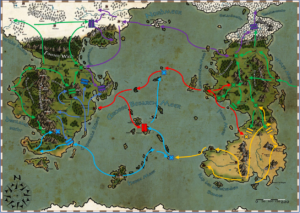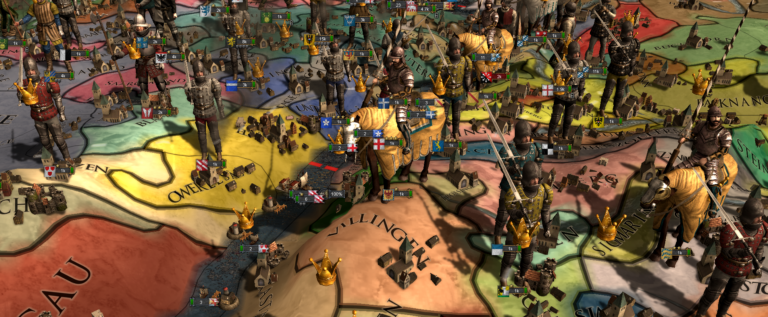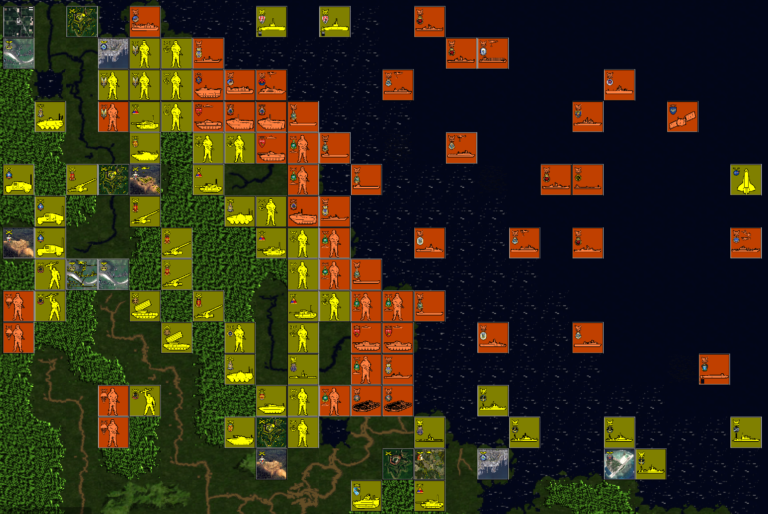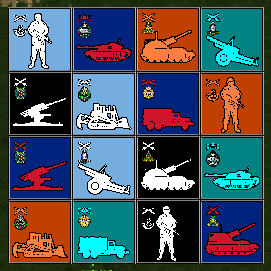Empire Deluxe Tournament 2019 – Finale
 This is the final and conclusive game of our 2019 tournament. This was the longest and hardest fought of the three, requiring a solid three days to complete. It was the only one to result in no capitals being taken by another player. It may not go down as one of our most indecisive or most memorable, but it was certainly interesting. It was also a deciding factor in naming this year’s MVP.
This is the final and conclusive game of our 2019 tournament. This was the longest and hardest fought of the three, requiring a solid three days to complete. It was the only one to result in no capitals being taken by another player. It may not go down as one of our most indecisive or most memorable, but it was certainly interesting. It was also a deciding factor in naming this year’s MVP.
The Start
The game map attached to this post shows the course of events as they played out. Note that due to a mapping imperfections, the true size of the continents is slightly wider. This will cause some distortions in the visuals but are a reflection of how events played out on the game map. Here are the starting locations for the first game:
| Red | Blue | Green | Pink | Yellow | Cyan |
| Feuer | Kuste | Niefsa | Dalian | Holak | Hexenberg |
First Half
The action starts with Holak. While their actual start was Aufgehenden, he announced early on his true intended capital was Holak and as a result was re-named for the sake of this write-up. As done the past two campaigns, Holak worked quickly to capture the southern end of the eastern continent uncontested. This was one of the most consistent actions taken in all three games, and the only player to successfully complete the same strategy all three times.
Feuer’s strategy this game was to cover all of the gaps in the strategy employed last game. It quickly gained a foothold on Riosu, Matsuba, and captured Xi’jing before any competition could take place. Unfortunately, this took most of the first half to complete but it would be one of the strongest defensive positions going into the second half.
The victors from last game relocated their capital from Gestila to Kuste for this session. The decision was based around capitalizing on the strategy of taking the Rek Valley quickly by moving it’s starting location closer to it’s war goal. However, attempting to repeat this strategy for a second time in a row would prove costly, as the competition attempted to use the exact same strategy. The Rek Valley is the only area that would see major action in the first half of the game.
Nordmeer opted to move it’s starting location to Dalian. The presumption was to allow a quick takeover of the eastern continent, but the true reason was an ingenious calculation that showed it was quicker to take over Nordmeer from Dalian and move towards the western continent that the other way around. In fact, it was the troop landings at Grunigen that stalled Kuste’s Rek Valley Campaign and resulted in the Battle of Jark Wagnarg.
Since its victory in game one, Taylo has slowly moved the capital south. In this game it would be Hexenberg, the site of the decisive conflict in game two. From here, it would launch a pre-emptive attack on the western continent as the opening move. It left the islands to the north alone assuming other nations would attempt to take them in the early rounds. This proved to be an incorrect assumption, but the result of this decision would be devastating to Kuste once the Battle of Gestila resulted in a foothold on the continent and the eventual capture of the lucrative Brenigen Valley.
The most surprising move in the first half was the strategic decision of Niefsa to abandon its home continent and make an immediate invasion of the eastern continent. This was a dangerous strategy based on the assumption that other nations would not allow Kuste to repeat last games success. As luck would have it, they were completely right. While the Battle of Jark Wagnarg went on, and the Feuer navy made its way across the Grosse Besaren Meer, Niefsa was marching across the Rongulay Mountains, capturing Tagaru, Dalka, and Uwatsuke uncontested.
Second Half
The announcement that a cease fire resulted from the Battle of Jark Wagnarg begins the second half. The terms of the ceasefire not known until later, but Kuste was left holding the field and some interesting information sharing from Dalian started. The battle had cost Kuste it had cost them the entire invasion force intended for the Rek Valley. The lack of air cover had costs Kuste dearly and by the time it built its second invasion force it was met with new resistance from Niefsa in what would become the Solstwald Campaign. Kuste had lost the initiative and risked the utter collapse of its entire strategy. The intel agreement with Dalian following the cease fire told of a surprise invasion force from Feuer on the other continent that threatened Kuste’s capital. It looked like their risky strategy had cost them the game entirely.
However, the intel reports from Dalian would prove to be a misdirection. After landing a token invasion force to capture Hafenheim, the Red Fleet turned south to capture the naval cities of Besaren. Kuste was saved when a Hexenberg fleet met them at the Battle of Negrada, resulting in an indecisive win for Hexenberg after the retreat of heavy naval assets. Negrada would remain in the hands of Feuer, but no transports from either side were sunk in the engagement.
Feuer would not be able to launch another amphibious invasion for the rest of the game. The reason was the discovery of a large host of Niefsa infantry in the Drachenwald. They joined forces with Dalian, but the combined ground and air forces of the two nations were defeated at the Battle of Imajin and the Battle of Kayta. It was a costly loss for Feuer and Dalian. The defeat at Imajin meant to loss of all its territory south of Amazonenpass. Feuer was pushed back to Matsuma but had lost nearly all of its ground forces in the pitched battles to the north as well as the losses during the Besaren Campaign. All that remained of Feuer‘s forces were its reserve assets, but these were seen by Niefsa as formidable.
Feuer concentrated all remaining forces, including its cruiser forces along the cost, for the anticipated Battle of Matsuma. However, Niefsa was send it’s air forces to Edujima in a surprise pincer movement, constructing multiple air bases along the coast to harass the Feuer capital instead. In one of the most incredible withdrawals of all three games, Feuer was able to use its cruiser fleet to blockade the Niefsa air forces and push a withdrawal of all ground forces out of Matsuba using the transport fleet returning from Battle of Negrada. It was incredible to watch. While Matsuba fell into the hands of Niefsa, Feuer took few losses and inflicted comparably heavy casualties. It meant Feuer could not be eliminated from the game any time soon as the bulk of its forces remained a serious threat in the area. Niefsa would instead opt to bottle of the fleet for as long as possible.
At this point there were only three players left on the eastern continent. Dalian’s forces were locked up behind Amazonenpass but Niefsa attacks at Frostberg had been repelled with heavy losses. They would take some dedicated effort to dislodge Dalian from the area. Holak controlled the entire southern end of the continent and two invasion attempts by Niefsa were repelled with heavy losses, showing this front would also require a dedicated effort. Still, both Dalian and Holak lacked the strength needed to push into Niefsa controlled territory and eventually agreed to coordinate their efforts, although to minimal effect.
Niefsa settled on the fact that it controlled the majority of the continent. Feuer’s last hurrah would come near the end of the game where it attempted to invade Holak and were repelled at the Battle of Riosu. This was a pyrrhic victory for Holak, as it depeated their defenses. As the game concluded, Niefsa took advantage and renewed their attack to the south. It was clear Niefsa had won control of the eastern continent.
Now we move to the west, where again the story was the strategy employed by Niefsa. After the capture of Roninwald, Niefsa dedicated all production east of Rongulay to support their efforts on the western continent. Kuste failed to capture the Rek Valley in the first half. Niefsa sent an expeditionary force into the valley with the intent to delay them while working on capturing the Zwergen Mountains. This delay resulted in a war of attrition as Kuste, desperate to capture the valley outright, focused on dislodging the entrenched Niefsa forces. This battle, fought almost entirely on forest and river tiles and moving constantly, was later called the Solstwald Campaign. In eventual frustration, and lacking proper intel to counter the ever increasing number of Niefsa fighters in the area, Kuste started ignoring the entrenched Green Force and just moved on. This caused the battle to become devastating for the valley, causing the entire Kuste strategy to fall apart as the war of attrition moved into the populated areas. However, by this time it didn’t matter to them. They clearly lost the decisive Battle of Heiliger Wald to Hexenberg to the south and with it any chance of re-conquering half of their former empire. They were just hoping to stay relevant by end game.
Despite their success in the south, Hexenberg immediately lost the Heiliger Wald when Niefsa attacked at the Battle of Gunberu, threatening the entire southern half. Unbeknownst to Hexenberg, the attacking force was the invasion force meant for an attack on Gestila which they believed was held by Kuste. Niefsa was unaware that a large Hexenberg force was in the area until this encounter. It is unknown of Hexenberg could have held them back, as the game would end before any major fighting on this front could happen. It will remain the one inconclusive battlefronts of the game.
In the north, Dalian managed to retain control of Piryat after a Niefsa invasion, but it lacked the ability to counter attack. This was only a diversion from Niefsa’s point of view, as it’s true goal was to capture Grunigen and envelop Kuste and conquer the Rek Valley outright. This ended up been a moot point, as by this point in the game Rek was virtually worthless after Kuste’s scorched earth invasion. The Battle of Grunigen would end up being a decisive victory after the expeditionary forces in the Solstwald would join the forces in the north Green Force and provide easy capture.
It was after this engagement concluded that the game was called. Only two players felt it was possible to claim victory at this point. While we would normally allow them to continue their struggle to the end, Dalian proposed a decision to share the tactical situation of all players which passed. After this showed the strength of Niefsa, Hexenberg announced its intent to resign as well which left Niefsa as the sole player who claimed a chance at victory. The war was over.
Conclusion
Niefsa avoided confrontation from any other nation in the first half of the game which left them in control of some important areas of the map, namely the Roninwald. This was never countered, especially after several ingenious tactical movements that saw them defeat the only successful coalition formed during the game. They effectively controlled all the key parts to the eastern continent by mid game and used it to devastate the western continent rather than try to capture it.
Kuste’s failed attempt to repeat success shows how risky his original strategy was. It fell apart exactly as it should once other players were aware of what he was doing. It is the definition of high-risk high reward. If they captured the Rek Valley unopposed as they did in Game Two, we all believe this would have been a stalemate between Niefsa and Kuste.
Feuer was one of the best played nations in this game. The complete withdrawal from Matsuba with minimal losses, is one of the most incredible moments of all three games. We all knew he was going to lose the battle, but despite knowing what he was doing to withdraw no one could stop him. He kept enough forces to remain a threat which delayed impending attacks against three other players. It was unfortunate he couldn’t capitalize on this. He would eventually lost the entire force in an assault on Riosu when we neared the end of the game.
Dalian just couldn’t figure out how to win. The most suprising outcome was how this nation turned into the UN. Dalian successfully negotiated a cease fire, played political intrigue, convinced another player to perform an attack that wasn’t in its best interest, and formed two seperate coalitions. All of this for a game that doesn’t have any in-game mechanics to support it. Moreover, he accomplished this while never being in a position to claim victory, although hedid harrass players. Everyone else had at least one delay in their plans as a result of his actions in this game.
Holak was the opposite. It’s the only starting point which consistently conquered a quarter of the map unopposed. Unfortunately, the distance between cities in this part of the map makes it easy to defend and hard to build a sizeable offense. In all three attempts, the bottleneck at Sumashim hurt Holak more than it did the players to the north, as no attempt was able to bypass the defenses. Despite this, we all agree that in a non-tournament game this location lives up to its name as a pirate’s haven as it would have excelled in this capacity.
Lastly, the poor Hexenberg. After they demonstrated the importance of a navy on this map in Game One, they were never able to overcome the power of other navies on the board. Hexenberg’s navy would not lose any engagement in the game, which led them to believe they were able to still claim victory. However, this game was determined based on land combat, not naval combat, and with Niefsa in control of two continents it would only be a matter of time before Hexenberg’s navy was overwhelmed as the amount of water it needs to patrol would be too much to overcome.
Tournament Conclusion
This map is not one of my favorites and did not grow on me the way Adallia did last year. I probably won’t play this map during any of our mid-year competitions like I did Adallia in 2019. Some starting points are truly stronger than others which is a killer for me. Still, it was one of the few approved tournament maps I still had on-hand that support six players natively. Despite any negativity I may show, I’m very thankful for a return of the six-player tournament format in 2019. There is nothing like starting a new year on a high after a well-played Empire tournament concludes.
That said, our MVP winner was unanimously decided as Niefsa. Each of his play throughs was stronger than the previous one and after reviewing the saved logs the strategy developed in the final game is the hardest one to counter of all the ones used. It’s also the one strategy that is likely to repeatedly work again which means he has figured out exactly how to play this starting position to maximum effect. This is a well earned addition to his wall of trophies he has collected over the years.
As is tradition, we also have Honorable Mentions. As part of this tradition, we retain player names from their most successful starts. This year we have two.
One was for Hatchel, our newest player, who successfully ran Holak and will be given this nickname going forward. Despite losing her capital on game one, she never lost control of the southern half of the eastern continent and repeatedly defended it from attacks to the north and be sea to the west. As is tradition, her new nickname will forever follow her success here.
The second honorable mention is Dalian. Dalian regains this nickname from a previous role in which he held the same name (from a different map). He successfully played the role of the Privateers of the Meer Sea. The constant harassment and invasion attempts kept us all on our toes. Moreover, he brought diplomacy to a war game and that cannot be understated. His misdirection and formation of coalitions brought an element to this game inproved the competitiveness of this tournament. Every one of us can recall at least one case where a surprise move by Dalian completely altered or delayed our plans elsewhere.
That concludes the 2019 Empire Deluxe Tournament. I’ll see you all again in 2020 when we attempt to dislodge Niefsa from his throne once more.




One Comment